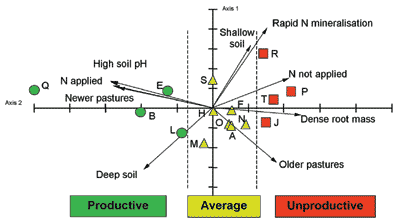| 2003 |

|
YEAR BOOK |
University of Limerick
|
Does farm grassland fertility depend on fertiliser inputs?
|
Agriculture relies heavily on fertilisers: however, because fertilisers may contaminate drinking water, Irish farmers apply less nitrogen nowadays. The research described here was carried out on fifteen grassland farms in Counties Limerick and Clare, and focuses on how grassland soil works in the context of reduced fertiliser inputs.


So, what drives grassland production? In the study, soil pH, pasture renewal, fertiliser N additions, soil depth, density of rooting (root mass), and nitrogen mineralisation activity were shown to influence production, but none explained outputs fully. Instead, when all the influential factors were graphed together (see Figure), farms became separated into productive (green), average (yellow) and less productive (red) groups, showing that grassland production is accounted for by all these factors, working together.
While N-fertilised farms were generally more productive, the organically-managed farm L produced more grass than the conventionally-managed farm Q receiving 230 kg N/ha/yr. So, although nitrogen inputs help, they are not the sole production determinant. Soil pH is important, as is the age of the pasture, and changing these without necessarily adding more N alone may improve soil fertility. Findings suggest that moderate N inputs, and moderate N mineralisation rates, serve both production and environmental purposes.
However, to optimise production while reducing N inputs, we need to understand how to manage the biological supply of N to grasses in the sward. Grassland management effects on soil biological activities are being investigated at the University of Limerick with Teagasc and EPA (Environmental Protection Agency) assistance.
Contact: Dr. Cecily Leonard, Dept. of Life Sciences, University of Limerick; E-mail: [email protected]